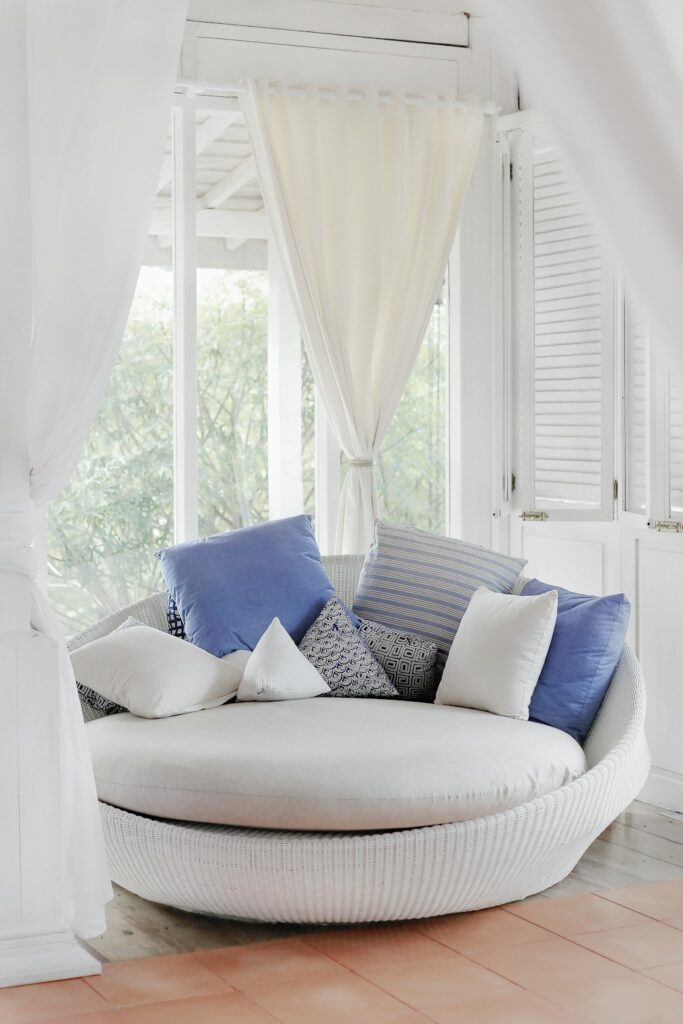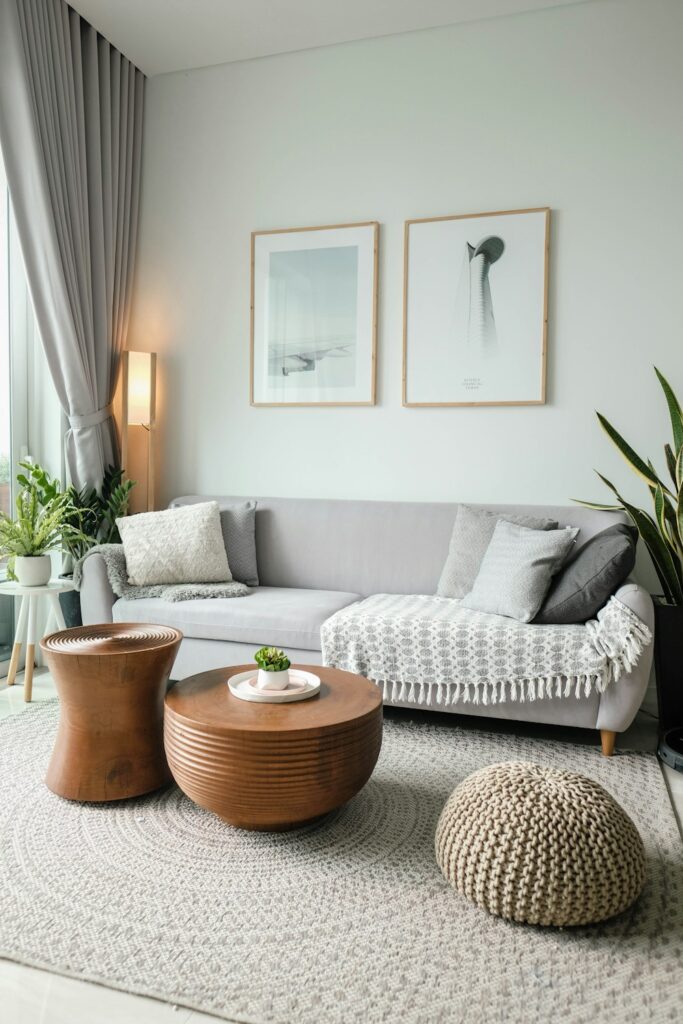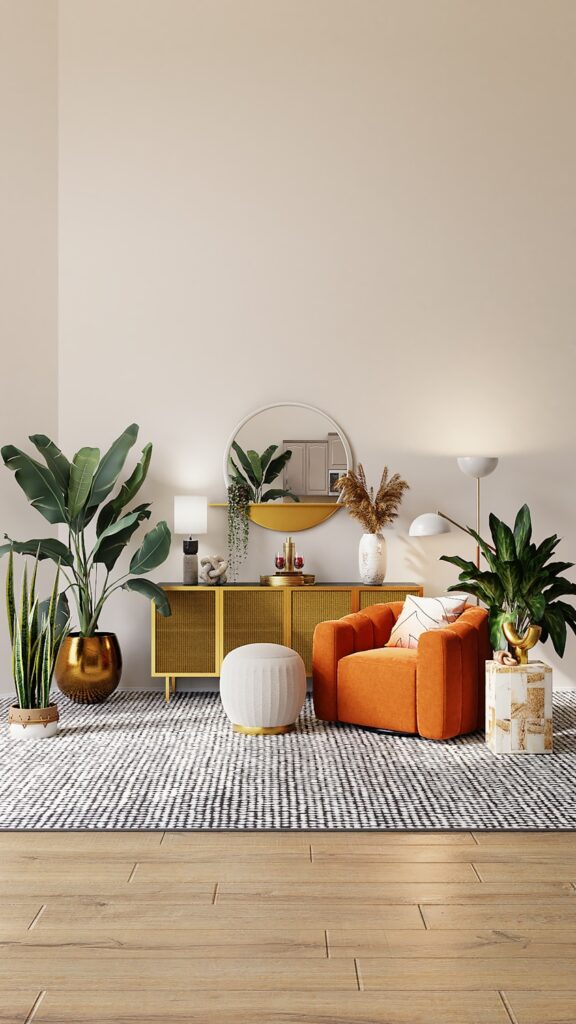I. Introduction: Making the Most of Small Spaces
Do you live in a small apartment, a cozy studio, or maybe even a tiny home? Sometimes, a small space can feel a bit challenging when it comes to decorating. You might think there’s not enough room for your things, or that you can’t make it look stylish. It’s easy to feel like you have to choose between having a lot of stuff and having a beautiful home.
But here’s a secret: small spaces are full of possibilities! With clever ideas and smart choices, you can make any tiny home feel open, organized, and truly stylish. It’s not about how much space you have, but how smartly you use it. You can have both comfort and great design, even in the smallest of rooms.
In this article, we’ll share “Genius Decor Tips” to help you transform your tiny home into a place that feels bigger, brighter, and perfectly reflects your style. These tips are easy to understand and put into action, no matter your decorating experience. Get ready to discover how to unlock the full potential of your small space!
II. Smart Furniture Choices: Maximize Every Inch
When every square foot counts, your furniture needs to work harder. Choosing the right pieces can make a huge difference in how your small space looks and feels.
- 1. Choose Multi-Functional Furniture: This is the golden rule for small spaces. Instead of furniture that does just one job, look for pieces that can do two or three! Think about a sofa that folds out into a bed (a sofa bed), an ottoman that opens for storage, or a coffee table that can lift up to become a dining table or a desk. Each piece earns its spot by serving multiple purposes. This saves space and makes your home more flexible.
- 2. Opt for Vertical Storage: When you can’t build out, build up! Use tall, narrow bookshelves, wall-mounted shelves, or cabinets that go all the way to the ceiling. This uses the empty space on your walls, freeing up floor space. Vertical storage helps keep things organized and makes your ceilings feel higher, which makes the room feel larger.
- 3. Use Nesting Tables: Nesting tables are a set of tables of different sizes that fit perfectly inside each other. When you need more surface area (like when guests come over), you can pull them out. When you don’t, they tuck away neatly, taking up very little space. They are super practical and look very chic.
- 4. Consider Wall-Mounted or Floating Furniture: Instead of bulky furniture with legs that take up floor space, look for items that can be mounted directly onto the wall. This includes floating shelves, wall-mounted desks, or even bedside tables. When furniture is off the floor, it creates a sense of openness and makes cleaning easier too.
- 5. Pick Furniture with Visible Legs: This might sound small, but it makes a big difference. Furniture with slender, visible legs (like a sofa or a console table) allows you to see the floor underneath it. This visual trick creates an illusion of more open space, making the room feel less crowded and lighter.
- 6. Choose Smaller Scale Furniture: Don’t try to fit a huge, bulky sofa into a tiny living room. Look for furniture that is designed for smaller spaces. These pieces are often narrower, shallower, or have a more compact design. They fit better without overwhelming the room. Measure your space carefully before you buy!
- 7. Built-in Storage Solutions: If you own your home or can make bigger changes, built-in storage is amazing. Think about custom shelves around a window, a bench with storage underneath, or even a bed frame with drawers built into it. Built-ins fit perfectly and use every bit of available space.
- 8. Foldable or Collapsible Furniture: For items you don’t use all the time, consider furniture that can be folded up and stored away. This could be a foldable dining table, folding chairs, or a collapsible laundry hamper. They are there when you need them and disappear when you don’t.
- 9. Use Transparent Furniture: Furniture made of clear materials like acrylic or glass can make a room feel much more open and airy. A clear coffee table or dining chairs won’t block the view, allowing your eye to travel through the space and making it feel less cluttered and larger.
- 10. Ottomans with Storage: An ottoman can be a footrest, an extra seat, or even a small coffee table with a tray on top. If you choose one with a lid that lifts, it also becomes a hidden storage spot for blankets, books, or toys. It’s a truly versatile piece for a small home.
III. Clever Storage Solutions: Declutter for Calm
A small space can quickly feel messy if things don’t have a proper home. Smart storage is key to keeping your tiny home tidy and peaceful.
- 11. Use Baskets and Bins: These are your best friends for hiding clutter. Use decorative baskets to store blankets, magazines, toys, or even shoes. Bins can go on shelves or under beds to keep smaller items organized and out of sight. Choose baskets that match your decor for a stylish look.
- 12. Embrace Under-Bed Storage: The space under your bed is often wasted. Use rolling storage containers, drawers, or even flat bins to store out-of-season clothes, extra linens, or anything you don’t need every day. This keeps items hidden and frees up closet space.
- 13. Over-the-Door Organizers: Don’t forget the back of your doors! Over-the-door organizers can hold shoes, toiletries, cleaning supplies, or even pantry items. They are perfect for bathrooms, closets, or utility rooms and use vertical space that would otherwise be empty.
- 14. Drawer Dividers and Organizers: Inside your drawers, things can quickly become a jumbled mess. Use drawer dividers, small trays, or even old small boxes to separate items like socks, underwear, kitchen utensils, or office supplies. This keeps everything neat and easy to find.
- 15. Wall Hooks and Pegboards: Install hooks on walls for coats, bags, keys, or even decorative items. A pegboard in a kitchen or craft area can hold tools, pots, or supplies, keeping them off counters and within easy reach. They are both practical and can look very stylish.
- 16. Utilize Corner Spaces: Corners are often overlooked. Use corner shelves, a small corner desk, or a narrow corner cabinet to make use of these awkward areas. They can provide valuable storage or display space without getting in the way.
- 17. Store Things Inside Other Things: Think creatively! Can you store your remote controls inside a decorative box on your coffee table? Can smaller serving dishes fit inside larger ones? Look for opportunities to nest items or store less-used items inside bigger ones to save space.
- 18. Magazine Files for Clutter: Magazine files aren’t just for magazines. Use them on shelves or in cabinets to store mail, papers, small electronics, or even cleaning supplies. They keep things upright and neat, making shelves look much tidier.
- 19. Clear Containers for Pantry/Fridge: Using clear containers for food in your pantry or fridge helps you see what you have. This prevents you from buying duplicates and helps you use food before it goes bad, saving money and reducing waste. Plus, it looks much more organized.
- 20. Use the Back of Cabinet Doors: Just like over-the-door organizers, you can attach small hooks, spice racks, or shallow bins to the inside of cabinet doors in your kitchen or bathroom. This is a great spot for small items like measuring spoons, cleaning cloths, or spices.
IV. Light & Color Tricks: Make Your Space Feel Bigger
The right use of light and color can magically make a small room feel much more open, airy, and inviting.
- 21. Paint Walls Light Colors: Light colors (like white, off-white, light gray, or pale blues and greens) reflect light. This makes a room feel brighter and more spacious. Dark colors tend to absorb light, making a room feel smaller and cozier, which is usually not what you want in a tiny home.
- 22. Use Mirrors Strategically: Mirrors are amazing for small spaces. A large mirror on a wall can make a room feel twice as big by reflecting light and the view. Place a mirror opposite a window to bring in more natural light and make the room feel more open.
- 23. Maximize Natural Light: Keep windows clear. Avoid heavy, dark curtains. Instead, use light-colored, sheer curtains or blinds that can be pulled all the way up. The more natural light you let in, the bigger and more inviting your space will feel.
- 24. Add Plenty of Artificial Light: Don’t rely on just one overhead light. Use different types of lighting: a floor lamp, a table lamp, and maybe some wall sconces. Good lighting in all corners of the room removes dark spots and makes the whole space feel larger and more welcoming.
- 25. Use a Monochromatic Color Scheme: This means using different shades and tones of the same color throughout your room. For example, all shades of blue, or all shades of gray. This creates a smooth, flowing look that helps the eye move easily around the room, making it feel less choppy and more expansive.
- 26. Hang Curtains High and Wide: When hanging curtains, place the curtain rod several inches above the window frame and extend it wider than the window. This makes the window appear larger and taller, drawing the eye upwards and making the ceiling seem higher.
- 27. Reflective Surfaces: Besides mirrors, use other reflective surfaces like glass tabletops, metallic accents, or glossy finishes on furniture. These surfaces bounce light around the room, adding brightness and making the space feel more open.
- 28. Keep Floor Colors Consistent: If you have an open-concept small space, try to keep the flooring the same throughout. This creates a continuous flow from one area to another, making the entire space feel larger and more connected, rather than broken up into tiny sections.
- 29. Use Sheer or Light Curtains: Heavy, dark curtains can make a small room feel closed off and cramped. Opt for sheer fabrics or light-colored, airy curtains that let light filter through. This maintains privacy while still allowing natural light to brighten your space.
- 30. Paint Ceilings Lighter than Walls: Painting your ceiling a lighter color (often white) than your walls can make the ceiling appear higher. This simple trick creates an illusion of more vertical space, making the room feel less confined.
V. Smart Decorating & Styling: Personalize Your Space
Even with limited space, you can still show off your personality and make your home feel uniquely yours.
- 31. Choose a Few Key Decor Pieces: Instead of many small knick-knacks that can create clutter, pick a few larger, impactful decor items. One big piece of art, a unique sculpture, or a beautiful plant can make a statement without making the room feel busy.
- 32. Use Area Rugs to Define Zones: In an open-concept small space, use area rugs to separate different areas. A rug under your sofa can define the living area, while another rug under a small dining table can mark the eating zone. This helps organize the space visually without needing walls.
- 33. Add Greenery (Plants!): Plants bring life, color, and a fresh feeling into any room. Even small plants on shelves or a tall, narrow plant in a corner can make a big difference. They add a natural touch and help purify the air.
- 34. Create a Focal Point: A focal point is something that immediately catches your eye when you enter a room. This could be a fireplace, a large piece of art, a unique piece of furniture, or a beautifully styled shelf. A focal point gives the room a purpose and draws attention away from its size.
- 35. Use Vertical Art Displays: Instead of spreading out many small pictures, create a gallery wall that goes vertically up the wall. This draws the eye upwards, making the ceiling feel higher and adding visual interest without taking up horizontal space.
- 36. Declutter Regularly: This is an ongoing process. Regularly go through your belongings and get rid of anything you don’t need, use, or love. The less clutter you have, the more spacious and peaceful your tiny home will feel. “A place for everything, and everything in its place.”
- 37. Incorporate Personal Touches: Your home should feel like your home. Display photos, souvenirs from trips, or handmade items that are special to you. These personal touches make your space unique and inviting, even if it’s small.
- 38. Use Trays to Group Items: On a coffee table, bedside table, or dresser, use decorative trays to group small items like remotes, candles, or jewelry. This makes the surface look more organized and less cluttered, even if there are many small things on it.
- 39. Consider a Rolling Cart: A small rolling cart can be incredibly useful. It can serve as a bar cart, a mobile office, extra kitchen storage, or a bedside table that can be moved around as needed. Its mobility makes it perfect for flexible small spaces.
- 40. Utilize Wall Niches or Recesses: If your home has any built-in wall niches or recesses, use them! These are perfect spots for displaying small decor items, books, or even adding a tiny light for ambiance. They provide depth and interest without taking up precious floor space.
VI. Functional & Aesthetic Enhancements: Smart Solutions
Beyond furniture and basic decor, there are other clever ways to make your small space both functional and beautiful.
- 41. Install Sliding Doors: If you have a regular door that swings open and takes up space, consider replacing it with a sliding barn door or a pocket door. These doors slide along the wall or into the wall, saving valuable floor space that a swinging door would need.
- 42. Use Wall-Mounted Lighting: Instead of bulky floor lamps or table lamps that take up surface space, opt for wall-mounted sconces or plug-in pendant lights. These provide good lighting while keeping your floor and tables clear.
- 43. Maximize Bathroom Storage: Bathrooms in tiny homes are often very small. Use slim storage cabinets, over-the-toilet shelving units, shower caddies, and drawer organizers to make the most of every inch for toiletries, towels, and cleaning supplies.
- 44. Keep Surfaces Clear: Try to keep flat surfaces like countertops, tables, and dressers as clear as possible. A cluttered surface makes a room feel messy and small. Only keep essential or decorative items out, and put everything else away.
- 45. Use a Pegboard in the Kitchen: A pegboard can be a lifesaver in a small kitchen. You can hang pots, pans, utensils, and even small shelves on it. This keeps your counters clear and makes everything easy to see and grab.
- 46. Invest in Good Quality Organizers: While it might seem like an extra cost, buying good quality organizers (like sturdy shelf dividers, clear bins, or drawer inserts) can save you money in the long run by helping you stay organized and preventing items from getting lost or damaged.
- 47. Create a “Drop Zone”: Near your entrance, create a small area (even just a wall hook and a tiny shelf) where you can immediately put keys, mail, and bags when you come in. This prevents clutter from spreading throughout your home.
- 48. Use Undershelf Baskets: In cabinets or on open shelves, you can often add undershelf baskets that hook onto the bottom of a shelf. This creates an extra layer of storage without needing more shelves, perfect for lighter items like dishtowels or plastic wrap.
- 49. Consider a Slim Rolling Pantry: For kitchens with limited cabinet space, a very slim rolling pantry unit can fit into tight gaps next to the fridge or between cabinets. It pulls out easily to reveal shelves for spices, cans, or other small items.
- 50. Embrace the “Less is More” Philosophy: Finally, the most genius tip for tiny homes is to truly embrace “less is more.” Every item you bring into your home should have a purpose or bring you joy. Be mindful of what you buy and what you keep. A minimalist approach helps your small space feel calm, spacious, and stylish.
VII. Conclusion: Your Stylish Small Space Awaits
You’ve now explored 50 genius decor tips designed to help you transform any tiny home into a stylish, functional, and comfortable living space! It’s clear that living in a small area doesn’t mean you have to sacrifice style or comfort. In fact, it encourages you to be more creative and thoughtful about your choices.
Remember, the key is to think vertically, choose multi-functional items, use light and color wisely, and keep clutter at bay. Each of these tips, whether it’s adding a mirror or choosing furniture with visible legs, contributes to making your home feel more open and inviting.
Don’t feel like you need to implement every tip at once. Start with a few that resonate with you and your space. Perhaps you’ll begin by decluttering a drawer, adding a large mirror, or finding a multi-functional piece of furniture. Small changes can lead to big impacts, making your tiny home feel perfectly tailored to you.
Get ready to unleash the full potential of your small space. With these genius decor tips, your stylish and organized tiny home awaits! Happy decorating!



